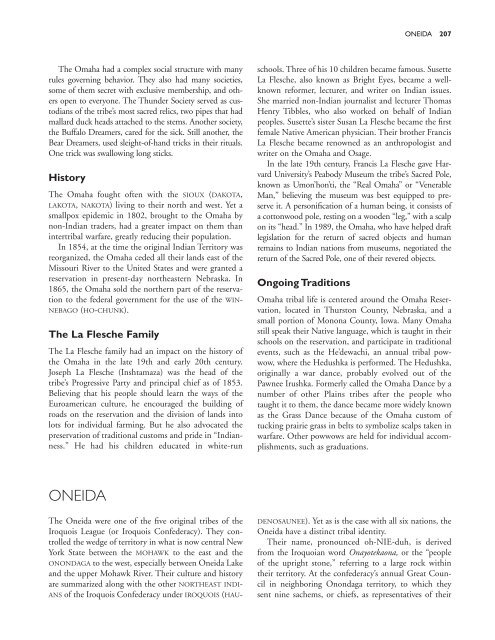Create successful ePaper yourself
Turn your PDF publications into a flip-book with our unique Google optimized e-Paper software.
ONEIDA 207<br />
The Omaha had a complex social structure with many<br />
rules governing behavior. They also had many societies,<br />
some <strong>of</strong> them secret with exclusive membership, and others<br />
open to everyone. The Thunder Society served as custodians<br />
<strong>of</strong> the tribe’s most sacred relics, two pipes that had<br />
mallard duck heads attached to the stems. Another society,<br />
the Buffalo Dreamers, cared for the sick. Still another, the<br />
Bear Dreamers, used sleight-<strong>of</strong>-hand tricks in their rituals.<br />
One trick was swallowing long sticks.<br />
History<br />
The Omaha fought <strong>of</strong>ten with the SIOUX (DAKOTA,<br />
LAKOTA, NAKOTA) living to their north and west. Yet a<br />
smallpox epidemic in 1802, brought to the Omaha by<br />
non-Indian traders, had a greater impact on them than<br />
intertribal warfare, greatly reducing their population.<br />
In 1854, at the time the original Indian Territory was<br />
reorganized, the Omaha ceded all their lands east <strong>of</strong> the<br />
Missouri River to the United States and were granted a<br />
reservation in present-day northeastern Nebraska. In<br />
1865, the Omaha sold the northern part <strong>of</strong> the reservation<br />
to the federal government for the use <strong>of</strong> the WIN-<br />
NEBAGO (HO-CHUNK).<br />
The La Flesche Family<br />
The La Flesche family had an impact on the history <strong>of</strong><br />
the Omaha in the late 19th and early 20th century.<br />
Joseph La Flesche (Inshtamaza) was the head <strong>of</strong> the<br />
tribe’s Progressive Party and principal chief as <strong>of</strong> 1853.<br />
Believing that his people should learn the ways <strong>of</strong> the<br />
Euroamerican culture, he encouraged the building <strong>of</strong><br />
roads on the reservation and the division <strong>of</strong> lands into<br />
lots for individual farming. But he also advocated the<br />
preservation <strong>of</strong> traditional customs and pride in “Indianness.”<br />
He had his children educated in white-run<br />
schools. Three <strong>of</strong> his 10 children became famous. Susette<br />
La Flesche, also known as Bright Eyes, became a wellknown<br />
reformer, lecturer, and writer on Indian issues.<br />
She married non-Indian journalist and lecturer Thomas<br />
Henry Tibbles, who also worked on behalf <strong>of</strong> Indian<br />
peoples. Susette’s sister Susan La Flesche became the first<br />
female <strong>Native</strong> <strong>American</strong> physician. Their brother Francis<br />
La Flesche became renowned as an anthropologist and<br />
writer on the Omaha and Osage.<br />
In the late 19th century, Francis La Flesche gave Harvard<br />
University’s Peabody Museum the tribe’s Sacred Pole,<br />
known as Umon’hon’ti, the “Real Omaha” or “Venerable<br />
Man,” believing the museum was best equipped to preserve<br />
it. A personification <strong>of</strong> a human being, it consists <strong>of</strong><br />
a cottonwood pole, resting on a wooden “leg,” with a scalp<br />
on its “head.” In 1989, the Omaha, who have helped draft<br />
legislation for the return <strong>of</strong> sacred objects and human<br />
remains to Indian nations from museums, negotiated the<br />
return <strong>of</strong> the Sacred Pole, one <strong>of</strong> their revered objects.<br />
Ongoing Traditions<br />
Omaha tribal life is centered around the Omaha Reservation,<br />
located in Thurston County, Nebraska, and a<br />
small portion <strong>of</strong> Monona County, Iowa. Many Omaha<br />
still speak their <strong>Native</strong> language, which is taught in their<br />
schools on the reservation, and participate in traditional<br />
events, such as the He’dewachi, an annual tribal powwow,<br />
where the Hedushka is performed. The Hedushka,<br />
originally a war dance, probably evolved out <strong>of</strong> the<br />
Pawnee Irushka. Formerly called the Omaha Dance by a<br />
number <strong>of</strong> other Plains tribes after the people who<br />
taught it to them, the dance became more widely known<br />
as the Grass Dance because <strong>of</strong> the Omaha custom <strong>of</strong><br />
tucking prairie grass in belts to symbolize scalps taken in<br />
warfare. Other powwows are held for individual accomplishments,<br />
such as graduations.<br />
ONEIDA<br />
The Oneida were one <strong>of</strong> the five original tribes <strong>of</strong> the<br />
Iroquois League (or Iroquois Confederacy). They controlled<br />
the wedge <strong>of</strong> territory in what is now central New<br />
York State between the MOHAWK to the east and the<br />
ONONDAGA to the west, especially between Oneida Lake<br />
and the upper Mohawk River. Their culture and history<br />
are summarized along with the other NORTHEAST INDI-<br />
ANS <strong>of</strong> the Iroquois Confederacy under IROQUOIS (HAU-<br />
DENOSAUNEE). Yet as is the case with all six nations, the<br />
Oneida have a distinct tribal identity.<br />
Their name, pronounced oh-NIE-duh, is derived<br />
from the Iroquoian word Onayotekaona, or the “people<br />
<strong>of</strong> the upright stone,” referring to a large rock within<br />
their territory. At the confederacy’s annual Great Council<br />
in neighboring Onondaga territory, to which they<br />
sent nine sachems, or chiefs, as representatives <strong>of</strong> their


















